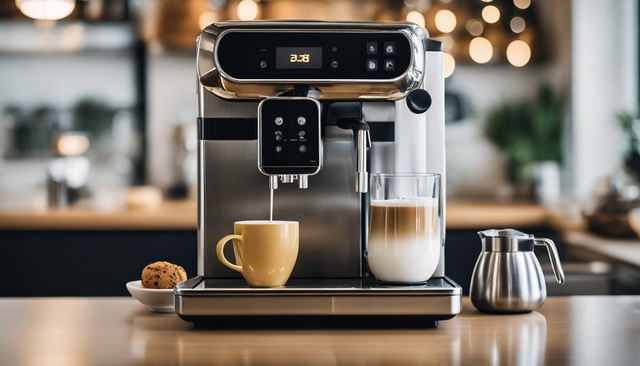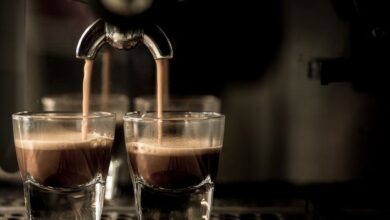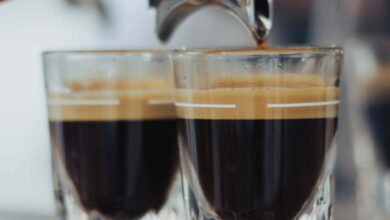Breve milk coffee is a delightful espresso-based drink that offers a creamy and rich flavor profile. It combines espresso with steamed half-and-half, creating a velvety texture that coffee enthusiasts love. The drink can be enjoyed in various ways, and its versatility makes it appealing to a wide range of palates.
As it gained popularity, breve milk coffee became a staple in coffee shops and among home baristas alike. It stands out not only for its taste but also for its ability to be customized with flavored syrups or alternative toppings. Understanding how to make and enjoy this beverage enriches the coffee experience significantly.
Breve milk coffee also invites comparison with other popular coffee drinks, emphasizing its unique qualities. Each cup tells a story of tradition and enjoyment, making it a must-try for anyone interested in coffee culture.
Key Takeaways
- Breve milk coffee is made with espresso and steamed half-and-half for a creamy texture.
- This drink can be customized with various flavors and makes a great addition to coffee menus.
- It offers a unique coffee experience that distinguishes it from other espresso-based beverages.
Understanding Breve Coffee
Breve coffee is an espresso drink made with steamed half-and-half instead of milk, offering a rich and creamy flavor profile. This section covers the essential characteristics of breve coffee and compares it to the more commonly known latte.
The Basics of Breve Coffee
Breve coffee, often referred to simply as “breve,” consists of a shot of espresso combined with steamed half-and-half. This distinctive choice of milk substitutes the usual whole or skim milk commonly used in other espresso drinks.
Key Features:
- Flavor: The half-and-half adds a velvety texture and a slightly sweeter taste compared to regular milk.
- Strength: Breve retains the strong espresso flavor, amplifying it through its rich dairy content.
- Serving Size: Typically served in standard espresso cup sizes, breve can also be enjoyed in larger formats.
Breve coffee’s richness often appeals to those seeking a decadent coffee experience. It differs significantly in taste and texture from other espresso beverages.
Breve Coffee vs. Latte
While both breve coffee and lattes begin with a shot of espresso, the choice of milk leads to notable differences in flavor and texture.
Comparison:
| Feature | Breve Coffee | Latte |
| Milk Type | Steamed half-and-half | Steamed whole milk |
| Texture | Creamy and rich | Smooth and lighter |
| Flavor | Rich, sweet profile | Milder, less intense flavor |
A latte typically has a lighter texture and less creaminess due to whole milk. In contrast, the breve coffee’s use of half-and-half amplifies its richness and creates a more indulgent experience.
Both beverages cater to different preferences, making them popular choices in coffee shops. Breve coffee is an excellent option for those who enjoy a richer, creamier coffee beverage.
The Role of Milk in Breve Coffee
Milk plays a crucial role in the preparation of Breve Coffee, enhancing its texture and flavor profile. Understanding the significance of Breve Milk and its specific characteristics is essential for appreciating this unique coffee beverage.
Breve Milk Explained
Breve Milk refers specifically to a blend of half-and-half that combines equal parts of whole milk and heavy cream. This mixture creates a creamy texture and a rich mouthfeel, contributing to the smoothness of Breve Coffee.
Breve Milk has a higher fat content compared to regular milk, approximately 10-12%. This richness not only balances the robust flavors of espresso but also allows for better frothing. The creamy nature of Breve Milk leads to a luscious espresso base, making it a favorite among those who enjoy decadent coffee beverages.
What Is Breve Milk?
Breve Milk is often used in specialty coffee drinks, particularly in place of traditional milk or cream. This versatility allows Breve Milk to be included in various espresso-based drinks, such as lattes and cappuccinos, adding a distinct flavor profile.
In addition to the unique taste, Breve Milk provides a velvety texture that enhances the overall drinking experience. This makes it an excellent choice for those seeking a richer coffee option without sacrificing the essence of the espresso. The balance of creaminess and coffee intensity offers a satisfying beverage that appeals to many coffee enthusiasts.
Making a Perfect Breve Coffee
Creating a delicious breve coffee involves careful selection of milk and precise frothing techniques. Both aspects are crucial in achieving the rich, creamy texture that defines this specialty drink.
Selecting the Right Milk
To make a perfect breve coffee, whole milk is preferred due to its high fat content, which contributes creaminess. Alternatively, half-and-half can be used for an even richer flavor and texture. It is essential to choose fresh milk, as this will affect the taste and frothing ability.
Consider the milk’s temperature before frothing; ideally, it should be cold before heating. Using organic or locally sourced milk may enhance the flavor profile.
If dietary restrictions exist, options like oat milk or almond milk can be used, but they may not froth as well as dairy milk. Testing different types will help in finding the best fit for personal preference.
The Frothing Technique
Frothing milk properly is key to crafting a perfect breve. Start by pouring the selected milk into a steaming pitcher, filling it to about one-third full.
Using a steam wand, submerge the tip slightly under the surface of the milk to create a whirlpool effect. This aerates the milk, producing microfoam.
Heat the milk to around 150°F (65°C) to achieve optimal froth without scalding.
Keep an eye on the texture; it should be smooth and velvety, without large bubbles. Pour the frothed milk over a shot of espresso, allowing the creamy texture to meld with the coffee for a satisfying finish.
The History and Origins of Breve Coffee
Breve coffee has its roots in Italian coffee culture. The word “breve” translates to “short” in Italian, referring to the beverage’s smaller size compared to traditional espresso drinks.
Originally, it was a way to prepare coffee using half-and-half instead of milk or cream. This approach created a richer and creamier texture, appealing to those who wanted something more indulgent.
As coffee culture evolved in the United States during the late 20th century, breve became popular in coffee shops. Baristas embraced it for its unique flavor profile and mouthfeel.
Breve coffee gained traction alongside espresso-based drinks such as lattes and cappuccinos. Its distinctive blend of espresso and rich dairy set it apart, allowing it to carve its niche in cafes across the nation.
Today, breve coffee is enjoyed in various forms, often customized with flavors and syrups. This evolution reflects the ongoing trends in coffee preparation, showcasing the remarkable adaptability of traditional beverages.
Breve’s history illustrates the interplay between cultural influences and innovative adaptations in the world of coffee.
Comparing Breves to Other Coffees
Breve coffee, often made with steamed half-and-half, provides a rich and creamy alternative to traditional coffee beverages. Its unique preparation and flavor profile set it apart, especially when compared to common drinks like a latte.
Breve Latte Differences
A breve latte uses half-and-half instead of the standard milk found in a regular latte. This substitution creates a thicker and creamier texture. The flavor is also intensified, offering a more luxurious mouthfeel.
In contrast, a typical latte consists of espresso and steamed whole milk, which results in a lighter consistency. The milk in a latte is usually frothy, while the breve latte is richer and less airy. For those who prefer an indulgent experience, the breve latte’s dense creaminess makes it a compelling choice.
Advantages of Choosing Breve
Choosing a breve offers several benefits for coffee enthusiasts. Firstly, the richness of half-and-half elevates the coffee’s flavor. It can balance well with the robust taste of espresso, allowing for a fuller-bodied experience.
Additionally, breve coffee may satisfy those who enjoy more substantial dairy in their beverages. The higher fat content can enhance the overall enjoyment for some, leading to a more decadent drinking experience.
Moreover, breve drinks often require smaller volumes to achieve the desired taste. This can lead to a more concentrated coffee flavor, catering to individuals looking for a stronger caffeine kick.
Nutritional Information of Breve Coffee
Breve coffee, crafted with espresso and steamed half-and-half, offers a rich and creamy experience. Understanding its nutritional makeup is essential for those monitoring caloric intake and health attributes.
Caloric Content and Health Considerations
A standard serving of breve coffee typically contains approximately 350-500 calories. The high caloric content primarily comes from the half-and-half, which is richer than regular milk.
The half-and-half used contributes not only calories but also fats—generally around 18 grams of fat per 12-ounce serving. This includes saturated fats, which can impact heart health if consumed excessively.
In terms of nutrients, breve coffee provides a source of calcium and vitamin D from the dairy. However, those with lactose intolerance should be cautious or consider alternatives to avoid digestive issues.
For individuals mindful of their diet, moderation is key. Understanding the caloric density helps in making informed choices about inclusion in daily meals.
Tips for Ordering Breve Coffee
Ordering a Breve Coffee can enhance the coffee experience. Understanding how to communicate your preferences clearly helps ensure you get the perfect cup.
How to Order at a Coffee Shop
When ordering, it’s essential to specify that you want a Breve Coffee, which is made with steamed half-and-half instead of milk. This detail is crucial as it impacts both the flavor and creaminess of the beverage.
Customers should inform the barista of their preferred size. Breve is delicious in any size, but larger cups may require more customization in milk or flavoring.
Additionally, mentioning any flavor syrups or sweeteners upfront is beneficial. Popular options include vanilla or caramel, but personal preferences vary. Adjusting the sweetness can dramatically change the overall taste profile.
Lastly, consider asking about the brewing method. Some shops may have specific techniques that enhance the Breve experience, such as espresso blends or extraction times.
Home Preparation of Breve Coffee
Breve coffee combines espresso with steamed half-and-half, creating a creamy and rich beverage. Preparing it at home requires some essential equipment and a clear guide to achieve the desired flavor and texture.
Essential Equipment for Home Brewing
To prepare breve coffee at home, specific equipment is essential.
- Espresso Machine: A high-quality espresso machine ensures that the coffee extracts properly, yielding a rich flavor.
- Milk Steamer: Many espresso machines come with a steam wand. This is necessary for frothing half-and-half to the right consistency.
- Coffee Grinder: A burr grinder is preferred for uniform grounds, which affects the brew quality.
- Measuring Tools: A scale or measuring spoon helps in accurately measuring espresso and half-and-half ratios.
- Thermometer: To monitor the temperature of the steamed half-and-half, preventing overheating.
These tools will facilitate the brewing process and enhance the final product.
Step-by-Step Guide to Making Breve at Home
- Prepare the Espresso: Start by grinding fresh coffee beans. Measure about 18-20 grams of coffee for a double shot.
- Brew the Espresso: Use the espresso machine to brew the coffee, aiming for a 25-30 second extraction for optimal flavor.
- Steam the Half-and-Half: Pour half-and-half into a steaming pitcher. Using the steam wand, heat it until it reaches about 150°F, creating velvety microfoam.
- Combine: Pour the steamed half-and-half over the brewed espresso. Aim for a 1:2 ratio of espresso to half-and-half for the best taste.
- Serve: Optionally, add flavorings such as vanilla or chocolate. Serve in an appropriate cup to enhance the experience.
Following these steps will result in a satisfying cup of breve coffee made in the comfort of home.
Serving and Enjoying Breve Coffee
Breve coffee offers a rich, creamy experience due to its combination of espresso and steamed half-and-half. Knowing how to serve and enjoy this beverage enhances its unique flavor and texture.
Pairings and Serving Suggestions
Breve coffee pairs well with both sweet and savory options. Pastries such as croissants and muffins complement its creaminess. Additionally, desserts like brownies or chocolate chip cookies work wonderfully, as their sweetness balances the robust coffee flavor.
For a savory touch, try serving breve with a cheese plate featuring mild cheeses. The creamy texture of the breve enhances the experience.
When serving, consider using a wide-brimmed mug to showcase the rich foam. Garnishing with a sprinkle of cocoa powder or cinnamon elevates both the taste and presentation, making it an ideal choice for any coffee lover.
Variations of Breve Coffee
Breve coffee, made with espresso and steamed half-and-half, offers a rich and creamy experience. There are several popular twists and variations to explore.
Popular Twists on the Classic Breve
There are many creative adaptations of the traditional breve coffee that enhance its flavor profile.
- Flavored Breves: Adding syrups like vanilla, caramel, or hazelnut provides a unique twist. These flavors complement the creaminess of half-and-half.
- Mocha Breve: Combining chocolate syrup with breve coffee results in a rich mocha flavor. This variation is popular among chocolate lovers who enjoy a sweet beverage.
- Breve Cortado: This drink mixes equal parts espresso and breve milk. The reduced milk creates a more potent coffee experience while maintaining creaminess.
Many coffee shops also offer seasonal variations, incorporating flavors like pumpkin spice or peppermint for a festive touch.
Iced Breve Options
Iced breve coffee is a refreshing alternative, perfect for warmer weather. This variation utilizes cold half-and-half and chilled espresso for a smooth taste.
- Iced Breve Latte: This drink combines iced espresso with half-and-half over ice. It provides a lighter, cooler take on the classic breve while maintaining its creamy texture.
- Iced Flavored Breve: Adding flavored syrups to an iced breve opens up new avenues for enjoyment.
- Frozen Breve: By blending espresso, half-and-half, and ice, a frozen breve drink is created. This variation offers a slushy texture and can be customized with various flavorings.
These iced options retain the essence of breve coffee while providing a refreshing experience perfect for a hot day.
Trends and Popularity of Breve Coffee
Breve coffee has gained traction in specialty coffee shops across the United States. Its creamy texture appeals to those looking for a rich and satisfying drink.
Several factors contribute to its rising popularity:
- Rich Flavor: The use of half-and-half instead of regular milk creates a velvety experience.
- Customization: Customers appreciate the ability to personalize their drinks with flavors or additional toppings.
- Social Media Influence: Instagram and TikTok showcase various coffee drinks, promoting unique creations like breve coffee.
The term “breve” itself indicates a style of coffee based on espresso and steamed half-and-half. This understanding helps consumers identify more choices in cafes.
As coffee enthusiasts seek out new experiences, breve coffee stands out. Many bars use it as a base for innovative drinks.
Establishments also offer breve options in seasonal flavors, enhancing customer choices.
In summary, breve coffee appeals to a wide audience. It combines traditional espresso culture with a modern twist, meeting both classic and contemporary tastes.
FAQs about Breve Milk Coffee
- How do you make the perfect breve milk coffee at home?
- To make the perfect breve milk coffee at home, start by brewing a shot of espresso. Then, steam half-and-half (a mixture of equal parts milk and cream) until it becomes frothy. Pour the steamed half-and-half over the espresso, stir gently, and enjoy your rich and creamy breve.
- What is the difference between a breve milk coffee and a latte?
- The main difference between a breve milk coffee and a latte is the type of milk used. A latte is made with steamed milk, while a breve uses steamed half-and-half, which makes the breve richer, creamier, and higher in fat content than a latte.
- Is breve milk coffee keto-friendly?
- Yes, breve milk coffee can be keto-friendly because it uses half-and-half, which is higher in fat and lower in carbohydrates than regular milk. This makes it suitable for those following a ketogenic diet, as long as it’s consumed without added sugars.
- What are some low-carb options for breve milk coffee lovers?
- Low-carb options for breve milk coffee lovers include using unsweetened almond milk or coconut milk instead of half-and-half, adding sugar-free syrups for flavor, or opting for a smaller serving size to reduce carbohydrate intake.
- Where can I find the best breve milk coffee near me?
- The best way to find a great breve milk coffee near you is to check local coffee shops and cafes that offer customizable espresso drinks. You can also read online reviews or use apps like Yelp or Google Maps to locate highly-rated coffee spots.
- What are the nutritional benefits of breve milk coffee?
- Breve milk coffee provides a richer source of fat and calories compared to regular coffee, thanks to the use of half-and-half. It can be a good option for those looking to increase their fat intake, particularly on a low-carb or keto diet, but it’s also higher in calories.
- How do you make a sugar-free breve milk coffee?
- To make a sugar-free breve milk coffee, brew a shot of espresso and steam unsweetened half-and-half. You can add sugar-free syrup or a sweetener like stevia if desired. Combine the steamed half-and-half with the espresso, stir, and enjoy a low-carb, sugar-free version of this creamy coffee.
- What is the history and origin of breve milk coffee?
- Breve milk coffee, known simply as “breve,” is an American variation of the Italian latte. It originated as a richer, creamier alternative to the traditional latte by using half-and-half instead of milk, which gives it its distinct texture and flavor.
- Can you make a dairy-free version of breve milk coffee?
- Yes, you can make a dairy-free version of breve milk coffee by using plant-based creamers like almond cream, coconut cream, or oat cream. These alternatives can be steamed just like half-and-half, though the texture and flavor might differ slightly.
- How many calories are in a standard breve milk coffee?
- The calorie count of a standard breve milk coffee can vary based on the size and the amount of half-and-half used. On average, a breve made with 4 ounces of half-and-half contains about 200-300 calories. Keep in mind that adding syrups or sweeteners can increase the calorie content.
- What makes breve milk coffee creamier than regular coffee drinks?
-
- Breve milk coffee is creamier than regular coffee drinks because it uses half-and-half (a mixture of milk and cream) instead of just milk. The higher fat content in half-and-half gives the coffee a richer, thicker, and more luxurious texture.
- Can I add flavored syrups to my breve milk coffee?
- Yes, you can add flavored syrups to your breve milk coffee to enhance its taste. Popular options include vanilla, caramel, hazelnut, or chocolate syrup. Be mindful of the sugar content if you are watching your carb intake.
- Why is breve milk coffee a popular choice among low-carb dieters?
- Breve milk coffee is popular among low-carb dieters because it uses half-and-half, which is lower in carbs and higher in fat compared to regular milk. This makes it a satisfying option for those on keto or other low-carb diets.
- How do you froth half-and-half for a perfect breve milk coffee?
- To froth half-and-half for breve milk coffee, use a steam wand or milk frother. Heat the half-and-half until it reaches a temperature of around 150°F (65°C), then froth it until it becomes creamy and slightly foamy. Pour it over your espresso for a smooth, rich coffee experience.
- What are the best plant-based alternatives to half-and-half for making a breve milk coffee?
- The best plant-based alternatives to half-and-half for making a breve milk coffee are almond cream, coconut cream, and oat cream. These options provide a similar creamy texture and can be steamed and frothed just like traditional half-and-half.
- Can I make a cold version of breve milk coffee?
- Yes, you can make a cold version of breve milk coffee by brewing your espresso, allowing it to cool, and then mixing it with cold half-and-half. You can also add ice for a refreshing iced breve coffee. Cold-frothed half-and-half can add a unique texture to the drink.
- What is the difference between a breve cappuccino and a breve latte?
- The difference between a breve cappuccino and a breve latte lies in the milk-to-espresso ratio and frothiness. A breve cappuccino has more foam and a stronger espresso flavor, with equal parts espresso, steamed half-and-half, and foam. A breve latte is creamier with less foam, containing more steamed half-and-half and a shot of espresso.
- How does the use of half-and-half in breve milk coffee affect its taste?
- The use of half-and-half in breve milk coffee enhances its taste by adding a rich, creamy, and slightly sweet flavor. The higher fat content creates a smooth, luxurious mouthfeel that is more indulgent compared to drinks made with regular milk.
- Can I customize my breve milk coffee to make it healthier?
- You can customize your breve milk coffee to make it healthier by using a smaller amount of half-and-half, opting for sugar-free syrups, or choosing a plant-based alternative with lower fat and calorie content. Adjusting the portion size and ingredients can help tailor the drink to your dietary needs.
- What is the origin of the term ‘breve’ in breve milk coffee?
- The term “breve” comes from the Italian word for “short,” but in the context of coffee, it refers to the use of half-and-half instead of milk. The name likely originated from American coffee culture, where this richer variation of a latte became known as a “breve.”








